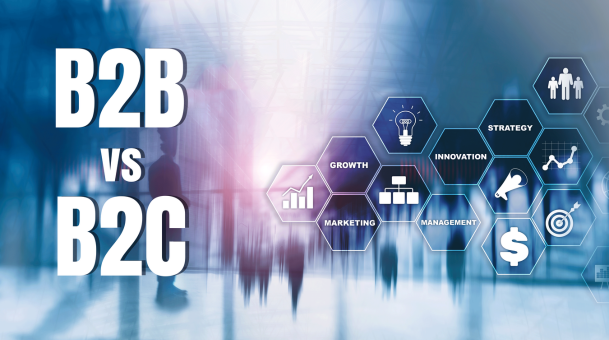Lead generation remains a cornerstone of successful business operations, fueling the sales pipeline and nurturing potential prospects into loyal customers. However, the approach to generating leads can significantly differ between Business-to-Business (B2B) and Business-to-Consumer (B2C) sectors. Understanding these distinctions is crucial for implementing effective strategies tailored to each audience. In this comprehensive guide, we’ll delve into the nuances of B2B vs. B2C lead generation strategies, highlighting the most effective channels and approaches for each.
Understanding the Core Differences
When diving into the realms of lead generation, distinguishing between Business-to-Business (B2B) and Business-to-Consumer (B2C) dynamics is not just crucial—it’s foundational to crafting strategies that resonate with your target audience and drive conversions. At the heart of this distinction lies the nature of transactions, the decision-making process, and the emotional underpinnings that characterize the buyer’s journey in each sector. Let’s delve deeper into these differences to lay a solid groundwork for understanding effective lead generation strategies.
The Nature of Transactions
B2B transactions are inherently complex, often involving high-value contracts that are pivotal to an organization’s operations and growth. These deals don’t just represent a financial exchange but a partnership that can shape the future trajectory of the businesses involved. This complexity is compounded by the fact that these transactions are typically not one-off purchases but ongoing engagements that require a deep understanding of the business needs, operational nuances, and strategic goals of both parties.
Conversely, B2C transactions are usually simpler and more straightforward. They often involve products or services that cater to personal needs or desires, with a relatively lower financial threshold. The focus here is on fulfilling an immediate need or desire, making the purchase decision more spontaneous and less encumbered by the layers of consideration that characterize B2B transactions.
The Decision-Making Process
In B2B environments, the decision-making process is a multifaceted journey often navigated by multiple stakeholders, each with their own set of expectations, objectives, and reservations. The sales cycle can span months or even years, involving numerous presentations, discussions, and revisions before a final decision is reached. This process is marked by a need for comprehensive information, detailed analysis, and often a demonstration of ROI before a commitment is made. It’s a path defined by rationality, where every step is measured against the potential impact on the organization’s broader goals.
In contrast, B2C decision-making is typically more individualistic and driven by personal preference, immediate need, or emotional response. The sales cycle is markedly shorter, with decisions often made on the spot or within a few days. Emotional appeals, such as branding and promotional offers, play a significant role in influencing these decisions. The buyer’s journey in the B2C world is more about personal satisfaction, convenience, and the emotional gratification derived from the purchase.
Emotional Underpinnings and Buying Journey
The emotional dynamics of B2B and B2C transactions differ significantly. B2B purchases are driven by logic, efficiency, and a clear business need. Emotional factors, while present, are more subtle and often tied to trust, reliability, and the anticipated long-term benefits of the partnership. The focus is on building relationships that foster confidence in the stability and quality of the services or products provided.
B2C purchases, however, are heavily influenced by emotional factors. Brand perception, user experience, and the promise of personal fulfillment play critical roles in shaping the consumer’s decision. The emotional connection a consumer feels with a brand can be the deciding factor in the purchase process, making emotional engagement a key strategy in B2C lead generation.
Understanding these core differences is essential for marketers and businesses aiming to develop targeted lead generation strategies. By acknowledging the unique challenges and opportunities inherent in B2B and B2C transactions, companies can tailor their approaches to resonate with their audience, whether they’re appealing to the logical, multifaceted decision-making process of businesses or the more spontaneous, emotionally driven behaviors of individual consumers.
B2B Lead Generation: A Strategic Approach
In the complex and nuanced world of Business-to-Business (B2B) transactions, the approach to lead generation must be methodical, data-driven, and tailored to meet the sophisticated needs of a professional audience. B2B companies are in the unique position of having to appeal not just to individual decision-makers but often to entire decision-making units comprising various stakeholders with different needs and pain points. This requires a deep understanding of the target audience, as well as a strategic use of channels and content that can effectively engage and convert potential leads. Let’s explore these aspects in more detail.
Target Audience: The Professional Buyer
B2B lead generation strategies must be developed with a clear picture of the professional buyer. This is a person or group that operates with a high level of scrutiny, looking for solutions that not only address immediate needs but also align with broader organizational goals and objectives. The messaging thus needs to be highly informative, directly addressing how your solutions can solve specific problems or improve operational efficiency, productivity, or profitability.
Preferred Channels for B2B Lead Generation
- LinkedIn: As the premier professional networking platform, LinkedIn stands out as an indispensable tool for B2B marketers. Its targeted advertising capabilities, combined with the opportunity to engage with professionals through thought leadership content, make it a powerful platform for connecting with decision-makers.
- Content Marketing: High-value content such as whitepapers, case studies, and industry reports can play a pivotal role in demonstrating a company’s expertise and insight. These resources help in establishing credibility and trust, showing potential leads not just what you do, but how you can address their specific challenges.
- Email Marketing: Through personalized email campaigns that cater to the unique needs and interests of each lead, businesses can nurture these prospects through the sales funnel. This involves sending timely, relevant, and valuable information that keeps your brand top of mind and encourages further engagement.
Effective Strategies for B2B Lead Generation
- Account-Based Marketing (ABM): ABM represents a highly focused approach to B2B marketing, where marketing and sales teams work together to target and engage specific high-value accounts with personalized campaigns. This approach not only increases the efficiency of marketing efforts but also aligns them closely with sales objectives, leading to higher conversion rates.
- Educational Content: In a landscape where the buyer’s journey is increasingly self-directed, providing educational content can help guide potential leads through the decision-making process. By positioning your brand as a source of valuable insights and solutions, you can build trust and authority in your industry. Webinars, tutorials, and insightful blog posts are examples of content that can educate and engage potential leads.
- SEO for Lead Generation: A strategic SEO approach is crucial for ensuring your valuable content is found by those looking for solutions you provide. By optimizing for relevant, high-intent keywords and focusing on niche topics within your industry, you can attract quality traffic to your site — traffic that’s more likely to convert into leads. This involves a deep understanding of your audience’s search behavior and the information they seek at different stages of the buyer’s journey.
In summary, B2B lead generation is a multifaceted endeavor that requires a deep understanding of the target audience, strategic use of preferred channels, and the implementation of targeted strategies designed to engage and convert professional buyers. By leveraging these elements effectively, B2B companies can generate high-quality leads that are more likely to result in long-term, profitable business relationships.
B2C Lead Generation: Connecting with Consumers
The Business-to-Consumer (B2C) landscape is dynamic and competitive, with companies vying for the attention of consumers in a marketplace saturated with choices. Successful B2C lead generation strategies hinge on understanding consumer behavior, preferences, and the emotional drivers that influence purchasing decisions. By leveraging the right channels and employing strategies that resonate on a personal level, B2C companies can effectively attract and convert leads into loyal customers. Let’s delve into the nuances of connecting with consumers in the B2C domain.
Target Audience: The Individual Consumer
In B2C marketing, the focus is squarely on the individual consumer. This audience makes purchasing decisions based on a combination of needs, desires, and emotional responses. The challenge for B2C marketers is to tap into these emotions, presenting solutions that not only fulfill a practical need but also resonate on a personal level. Understanding the consumer persona—preferences, behaviors, and pain points—is crucial for crafting messages that captivate and compel action.
Preferred Channels for B2C Lead Generation
- Social Media Platforms: Instagram, Facebook, and TikTok have become essential tools in the B2C marketer’s arsenal. These platforms offer unparalleled opportunities to engage with consumers through visually compelling content, interactive features, and highly targeted advertising. The key is to create content that not only grabs attention but also encourages shares and conversations, amplifying your reach.
- Influencer Marketing: Consumers trust recommendations from people they admire or relate to. Partnering with influencers allows brands to tap into this trust, leveraging the influencer’s reach and credibility to promote their products or services. The authenticity and relatability of influencer partnerships can significantly boost brand visibility and lead generation.
- SEO and Content Marketing: By producing content that addresses common questions, interests, or entertainment needs of your target audience, you can attract visitors to your website organically. SEO-optimized blog posts, videos, and other content formats can improve your visibility in search engine results, drawing in consumers actively seeking information or solutions.
Effective Strategies for B2C Lead Generation
- Emotional Engagement: Emotion is a powerful driver in consumer decision-making. B2C strategies that leverage storytelling, compelling visuals, and relatable narratives can create a strong emotional connection with the brand. This connection not only attracts leads but also fosters brand loyalty and advocacy.
- Special Offers and Incentives: Consumers are often motivated by the prospect of getting a good deal. Discounts, coupons, flash sales, and exclusive offers create a sense of urgency, encouraging consumers to act quickly. These tactics can effectively move leads through the funnel, from initial interest to purchase.
- User Experience (UX): In the B2C realm, the online experience can make or break a sale. A seamless, intuitive, and enjoyable user experience—from browsing products on a website to the checkout process—is essential for converting leads into customers. This includes fast loading times, mobile optimization, easy navigation, and a secure, straightforward checkout process.
In conclusion, B2C lead generation is about more than just capturing the attention of consumers—it’s about creating experiences that resonate on a personal level, making it easy and desirable for consumers to choose your brand. By focusing on emotional engagement, leveraging the right channels, and ensuring a positive user experience, B2C companies can build a strong pipeline of leads and convert them into loyal customers.
Measuring Success in Lead Generation
The ability to measure and analyze the effectiveness of lead generation strategies is fundamental to refining and improving marketing efforts, regardless of whether you are operating in a B2B or B2C context. By leveraging key performance indicators (KPIs), businesses can gain insights into what works, what doesn’t, and how to allocate resources for the best return on investment. However, it’s crucial to recognize that the metrics of success, as well as the strategies themselves, can vary significantly between B2B and B2C sectors due to differences in sales cycles, purchase values, and decision-making processes. Let’s delve into how success can be measured and what KPIs are most indicative of effective lead generation strategies in both domains.
Key Performance Indicators (KPIs) for Measuring Success
Conversion Rates: The conversion rate, or the percentage of leads that become paying customers, is a critical metric for both B2B and B2C businesses. It provides a direct measure of how effectively a lead generation strategy is moving potential customers through the sales funnel. A low conversion rate may indicate that the leads are not well-qualified or that there are obstacles in the sales process.
Cost Per Lead (CPL): CPL measures the cost-effectiveness of lead generation campaigns, calculated by dividing the total cost of the campaign by the number of leads generated. This metric helps businesses understand the financial efficiency of their lead generation efforts and can be crucial for budgeting and resource allocation.
Return on Investment (ROI): ROI is the ultimate measure of the success of any marketing initiative, indicating the financial return generated from the investment in lead generation activities. A positive ROI signifies that the lead generation strategy is effective in generating revenue that exceeds its cost.
B2B vs. B2C Benchmarks for Success
Sales Cycle Length: B2B transactions typically involve longer sales cycles due to the complexity of the purchasing decision and the involvement of multiple stakeholders. Consequently, B2B marketers may place a greater emphasis on metrics related to lead nurturing and engagement over time, such as lead progression rates or the effectiveness of different touchpoints in moving leads through the sales funnel.
Purchase Value: The generally higher value of B2B transactions compared to B2C sales means that B2B businesses may tolerate a higher cost per lead, provided that the leads are highly qualified and have a strong potential to convert into high-value customers. In contrast, B2C strategies often aim to optimize for lower CPL and higher volume, reflecting the lower individual purchase value but greater scalability.
Decision-Making Process: The individual and impulsive nature of B2C purchasing decisions means that metrics such as website traffic, click-through rates (CTRs), and immediate conversion rates can be more indicative of success. In contrast, B2B marketers might focus more on engagement metrics, such as time spent on educational content, webinar attendance, or interaction with email campaigns, which reflect the more considered and collaborative decision-making process in B2B contexts.
Continuous Optimization Through Analysis
The key to successful lead generation in both B2B and B2C sectors lies in continuous monitoring, analysis, and optimization of strategies based on performance metrics. By setting benchmarks, regularly reviewing KPIs, and adapting strategies in response to insights gained, businesses can improve their lead generation efforts, achieve better alignment with their target audiences, and ultimately increase their ROI. It’s also essential to consider industry-specific benchmarks and trends, as these can provide additional context for evaluating the effectiveness of lead generation strategies.
The distinction between B2B and B2C lead generation strategies lies in understanding the audience, their decision-making process, and the channels through which they are most accessible. By tailoring approaches to these nuances, businesses can optimize their lead generation efforts, whether they’re aiming to close high-value contracts or attract consumer purchases. Remember, the ultimate goal is to create value for your prospects, guiding them smoothly from initial awareness to the final decision.


